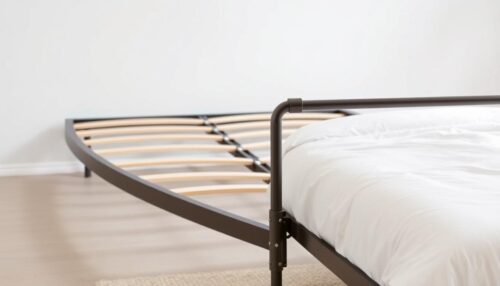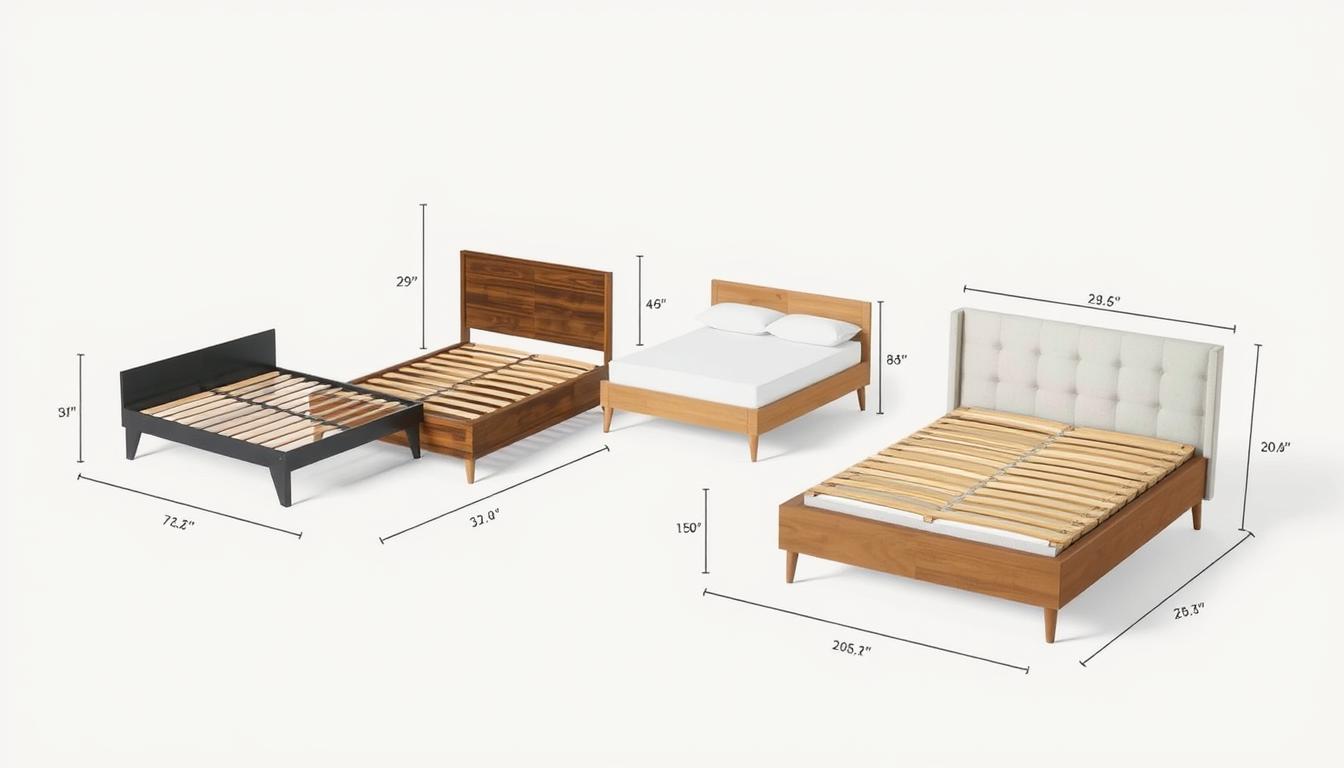Disclosure
This website is a participant in the Amazon Services LLC Associates Program, an affiliate advertising program designed to provide a means for us to earn fees by linking to Amazon.com and affiliated sites.
Turning your bedroom into a cozy space starts with your bed frame. Bed frames vary in size, from twin to California king. Knowing your frame’s size is key for a perfect headboard fit.
Standard bed sizes range from 38 x 75 inches for twin to 72 x 84 inches for California king. Your frame’s width and length decide the headboard size you need. After measuring, you can pick the right headboard for your decor.
Adding a headboard to your bed frame is easy. With the right tools and a bit of knowledge, you can change your bedroom’s look quickly. You can choose from wooden, metal, or upholstered headboards. We’ll show you how to attach a headboard, from tools to common issues.
Table of Contents
Key Takeaways
- Bed frames come in standard sizes like twin, full, queen, king, and California king
- Knowing your bed frame dimensions is key for the right headboard size
- Headboards can be made from wood, metal, and fabric
- Attaching a headboard to a bed frame is simple with the right tools
- Proper installation makes your headboard secure, stable, and looks great
Understanding Different Types of Headboards
Headboards are key in designing your bedroom. They set the style and tone. You can choose from many types, like wooden or metal designs. Knowing what each offers helps pick the right one for your bed and room.
Fabric Headboards
Fabric headboards add a cozy feel to your room. They’re soft, made from velvet, linen, or microfiber. You can find them in many colors and patterns to match your decor.
Wooden Headboards
Wooden headboards are durable and timeless. They fit both old and new bedroom styles. Made from pine, oak, or maple, they can be simple or detailed. They give your bed a strong, classic look.
Metal Headboards
Metal headboards, like wrought iron or stainless steel, add a bold look. They can have fancy designs or simple shapes. Great for platform or bunk beds, they offer both style and strength.
Upholstered Headboards
Upholstered headboards mix comfort with style. They’re padded and covered in various materials. You can add tufting or nailhead trim to make them unique.
Choosing the right headboard can change your bedroom’s look. Knowing about different headboards helps you pick one that fits your taste and room perfectly.
Tools and Materials Needed for Headboard Attachment
Attaching a headboard to your bed frame is easy if you have the right tools and materials. Let’s look at what you need for a successful headboard installation.
Essential Tools
- Power drill or screwdriver
- Measuring tape
- Level
- Stud finder (for wooden bed frames)
Recommended Materials
What you need depends on your bed frame and headboard. Here are some common items:
- Appropriate screws or bolts
- Washers
- Headboard brackets or mounting hardware
Make sure to pick the right fasteners for a strong and lasting attachment.
Safety Equipment
Protect yourself with safety gear during installation. Here’s what you should have:
- Work gloves
- Safety glasses
With the right tools, materials, and safety gear, you’re ready to attach your headboard.
Preparing the Bed Frame and Headboard for Attachment
Before attaching your new headboard, you need to prepare. Clean both the headboard and bed frame well. This removes dust and dirt that could mess up the installation.
Cleaning the Headboard and Bed Frame
Begin by wiping the headboard with a soft cloth or microfiber duster. This removes dirt and grime. For wooden headboards, a mild wood cleaner can restore shine.
When cleaning the bed frame, pay extra attention to where the headboard will go. Make sure the surface is smooth and even.
Ensuring Proper Alignment
After cleaning, align the headboard with the bed frame. Measure the bed frame’s width and height to find the perfect spot for the headboard. Use a tape measure to mark where the headboard will go.
By preparing the bed frame and headboard well, you’re ready for a smooth headboard installation. This care ensures a strong and attractive look in your bedroom.
Attaching a Headboard to a Metal Bed Frame
Attaching a headboard to a metal bed frame is easy. You just need to use special brackets or bolts. Make sure the headboard and frame line up right for a strong hold.
Steps for Metal Frames
- First, measure your metal bed frame’s width. This will help you pick the right headboard size.
- Then, clean the bed frame and headboard. Remove dirt and dust to help the attachment go smoothly.
- Place the headboard on the bed frame. Make sure it’s straight and in the middle. Mark where you’ll attach the brackets.
- Drill small holes in the frame where you marked. Be careful not to scratch the finish.
- Put the brackets on the frame with bolts, washers, and nuts. Tighten them well, but don’t overdo it.
- Now, attach the headboard to the brackets. This should make it stable and secure.
Common Challenges and Solutions
One big problem is when the mounting holes don’t match. Adjustable brackets can solve this. If the metal is too thick, you might need longer bolts or special parts. Sometimes, you have to drill new holes to get a good fit.

By following these steps and solving any problems, you can attach a headboard to your metal bed frame. This will make your bedroom look neat and put together.
Attaching a Headboard to a Wooden Bed Frame
Attaching a headboard to a [wooden bed frame] is easy if the frame is made for it. Just make sure it’s aligned right and attached well for stability.
Steps for Wooden Frames
- Measure your [wooden bed frame] to find the best headboard size and spot.
- Mark where the headboard will go on the bed frame.
- Drill holes in those spots to avoid splitting the wood.
- Put wood glue on the spots to help the headboard stick better.
- Use screws or bolts to hold the headboard in place, making sure they’re tight.
Tips for Stability
To keep your [headboard installation] stable and lasting, follow these tips:
- Choose strong screws or bolts made for wood.
- Use wood glue with the fasteners for a stronger hold.
- Check the tightness of the connections often and adjust as needed.
- Choose a headboard that matches your [wooden bed frame] for a nice look.
By following these steps and tips, you can attach a headboard to your wooden bed frame well. This will make your sleeping area look good and feel stable. Always check the maker’s instructions for your [wooden bed frame] model.
For more on [headboard installation] and making your bedroom your own, see the full guide at Puffy.com.
Using Adjustable Brackets for Headboard Attachment
Adjustable brackets make attaching a headboard to your bed frame easy. They let you place your headboard exactly where you want it. This makes them a favorite among those who love their bedding.
Benefits of Adjustable Brackets
Adjustable headboard brackets have many benefits. They let you change the height and depth of your headboard. This means you can fit different sizes and styles of headboards to your bed frame.
Installation Process
Installing adjustable headboard brackets is simple. First, attach the bracket channels to your bed frame. Then, connect the headboard flanges to the brackets. Lastly, tighten the bolts to hold the headboard in place.
These brackets work well with both flexible bed frame attachments and traditional frames. They make attaching a headboard easy and let you customize your bedroom.
For a good headboard attachment, measure carefully and align properly. Adjustable brackets help you get the right mix of function and style. This turns your bedroom into a cozy and stylish retreat.
Securing the Headboard Without Drilling
Attaching a headboard to your bed frame doesn’t always need drilling. There are many ways to do it without power tools or changing your furniture. These methods are perfect for renters, apartment dwellers, or anyone who likes to change things up.
Alternative Attachment Methods
- Pressure-Mounted Brackets: These brackets use tension to grip the wall or bed frame. They let you easily install and remove the headboard as needed.
- Hook-and-Loop Fasteners: Also known as Velcro, these fasteners provide a strong hold. They also let you move the headboard easily.
- Freestanding Headboards: Some headboards are made to stand on their own. They rest against the wall without needing to be attached. These are a great no-drill headboard attachment choice.
Pros and Cons
The main benefit of these methods is how easy and flexible they are. You can install them without harming your walls or bed frame. This makes them great for renters or anyone who likes to redecorate.
But, these methods might not be as stable as drilling. You might have fewer options for where to place your headboard.
When picking the best bed frame alternatives, think about a few things. Consider the weight of your headboard, the material of your wall or frame, and how stable you need it. Trying out a few options can help you find the best way to attach your headboard without damage.
Decorating Your Headboard Post-Attachment
After attaching your headboard, it’s time to make your bedroom look amazing. Decorating your headboard can really change how your bedroom looks. It lets you show off your style and make the room look better.
Popular Decorating Styles
There are many ways to decorate your headboard. Look for styles that match your bedroom’s look. Here are some popular ones:
- Minimalist – This style uses simple designs and calm colors for a peaceful feel.
- Bohemian – It’s all about bright colors, fun patterns, and natural stuff for a relaxed vibe.
- Classic – This style is all about timeless looks, like tufted seats or fancy woodwork, for a fancy feel.
Accessorizing Ideas
To make your headboard even more special, add some accessories. Here are some cool ideas:
- Hang art or mirrors above the headboard to draw attention.
- Put LED lights behind the headboard for a cozy glow.
- Use throw pillows or blankets in matching colors and textures.
By trying out different headboard decoration and bedroom styling ideas, you can turn your bedroom into a cozy and beautiful place.

Maintenance Tips for Your Headboard and Bed Frame
Keeping your headboard and bed frame in good shape is key. It helps them last longer and keeps your bedroom looking great. We’ll cover the main steps to keep your bedding area in top shape.
Cleaning and Care
The cleaning method for your headboard and bed frame depends on the material. Fabric headboards can be gently vacuumed or spot cleaned. Wooden or metal frames need more dusting and polishing to stay shiny.
- Vacuum fabric headboards often to avoid dust.
- Spot clean fabric headboards with a mild detergent and water.
- Dust wooden or metal frames with a soft, microfiber cloth.
- Polish wooden frames with furniture polish to keep the finish.
- Wipe down metal frames with a damp cloth to stop rust or corrosion.
Periodic Checks
It’s vital to check your headboard and bed frame regularly. This ensures they stay stable and secure. Look for any loose screws or bolts and tighten them.
- Make sure the headboard is well attached to the bed frame.
- Tighten any loose screws or bolts on the headboard and bed frame.
- Look for wear or damage on the frame and fix it right away.
- Adjust the headboard’s height or depth for a comfy sleep.
By following these tips, you can make your headboard and bed frame last longer. This ensures a cozy and stylish sleep area for many years.
Troubleshooting Common Headboard Attachment Issues
Attaching a headboard to your bed frame can sometimes present unexpected challenges. But with a little troubleshooting, you can resolve common issues. This ensures a secure, stable attachment. Let’s explore solutions for two of the most common headboard attachment problems.
Loose Headboard Solutions
If your headboard feels loose or unstable, it’s essential to address the problem promptly. The first step is to carefully inspect all the connections. Tighten any screws or bolts that may have become loosened over time.
You can also try adding extra support brackets or reinforcements. This will help stabilize the headboard and prevent it from shifting.
Adjusting Height and Depth
Achieving the perfect height and depth for your headboard can take some trial and error. If the headboard isn’t sitting at the desired position, you may need to remount it on the bed frame. Many headboards come with adjustable brackets.
This allows you to fine-tune the placement, making it easy to get the look and feel you want. Remember to double-check the stability and alignment after making any adjustments.
Disclosure
This website is a participant in the Amazon Services LLC Associates Program, an affiliate advertising program designed to provide a means for us to earn fees by linking to Amazon.com and affiliated sites.

